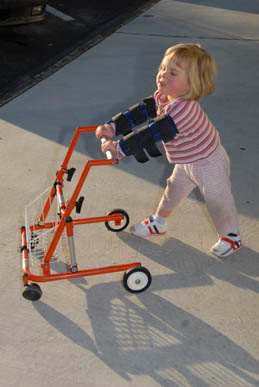Category — 2.1 Children with Pervasive Developmental Disorders (PDD): Rett Disorder
Children with Rett Syndrome
Rett syndrome is a disorder that primarily affects girls. Like children with ASD, children with Rett syndrome experience difficulty learning how to talk and relate to others. They may also engage in self-stimulatory (see full Glossary) and/or repetitive behaviors, and may have difficulty regulating their sensory system.
Children with Rett syndrome often start life developing like any typical child. Sometime between the ages of 6 months and 2 years, the brains of children with Rett syndrome stop developing. When this happens, these children end up losing some of the skills they have learned. Brain development may resume, but after a period of non-growth. All lost skills will have to be re-taught.
Description
Children with Rett syndrome (Fig. 1) often have seizures and many of them keep wringing and unwringing their fingers. Children with Rett Syndrome require ongoing individualized attention from their parents and caregivers. Their needs are high in terms of their health, behavior and safety. These children also require frequent follow up with their regular feeding, dressing, changing and bathing routines. Parents and caregivers may experience exhaustion and, in some cases, despair when situations get to be overwhelming. Home support and ongoing intervention for parents and caregivers is essential to prevent parents from “losing” their sense of being in charge of their kids.
Intervention options are strategies, programs and resources that are available for parents and for service providers working with children with additional needs, and the professionals working with children and families:
- Infant or child support development consultant through the Infant Development Program/ Aboriginal Infant Development Program Supported Child Development Program/ Aboriginal Supported Child Development
- Sensory Integration therapy
- Academic preparation: children with Rett syndrome may have difficulties with specific learning skills and will benefit from the help of small group and/or individualized learning support from a resource teacher. An Individualized Educational Program or Plan (IEP) needs to be in place for children with Rett syndrome.
Interventionists working with children with Rett syndrome include the following:
- Occupational therapist
- Physiotherapist
- Behavioral therapist
- Speech language pathologist
- Mental health therapists
March 3, 2011 No Comments
